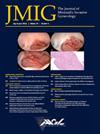Mastering Robotic Myomectomy: Harnessing Knowledge, Technique and Technology for Surgical Excellence
IF 3.5
2区 医学
Q1 OBSTETRICS & GYNECOLOGY
引用次数: 0
Abstract
Study Objective
To assess the efficacy and safety of minimally invasive robot-assisted myomectomy in treating a patient with multiple uterine fibroids.
Design
Case report detailing the surgical intervention and outcomes of a patient with symptomatic uterine fibroids.
Setting
Patient in lithotomy position, robot docking at patient pelvic left side, with 3 robotic trocars and one laparoscopic 11mm assistant port.
Patients or Participants
Case report of a 39-year-old woman.
Interventions
The patient underwent treatment with Goserelin acetate to reduce the size of the uterus, followed by minimally invasive robot-assisted myomectomy. During the surgery, uterine arteries and round ligaments were located, clipped, and temporarily clamped to minimize bleeding. Fibroids were meticulously dissected and removed using laparoscopic ultrasound guidance.
Measurements and Main Results
The surgery lasted approximately 3 hours, during which 14 fibroids were removed. Blood loss was minimal, with the patient losing only 100ml. Postoperative recovery was favorable, with the patient experiencing mild abdominal pain and being discharged within 20 hours. Pathology confirmed the removal of all leiomyomas.
Conclusion
Minimally invasive robot-assisted myomectomy, combined with meticulous identification and clipping of uterine arteries, proved effective in reducing uterine size and improving symptoms in this patient with multiple uterine fibroids. This approach offers a promising option for the management of symptomatic fibroids, enhancing patient outcomes and quality of life.
掌握机器人子宫肌瘤切除术:利用知识、技术和科技打造卓越手术
研究目的评估微创机器人辅助子宫肌瘤剔除术治疗多发性子宫肌瘤患者的有效性和安全性。患者或参与者一名39岁女性的病例报告干预患者接受醋酸戈舍瑞林治疗以缩小子宫体积,随后接受微创机器人辅助子宫肌瘤剔除术。手术中,找到子宫动脉和圆韧带,剪断并暂时夹住,以减少出血。手术持续了约3个小时,共切除了14个肌瘤。失血量极少,患者仅失血100毫升。术后恢复良好,患者腹痛轻微,20小时内出院。结论事实证明,微创机器人辅助子宫肌瘤剔除术结合细致的子宫动脉识别和剪切,能有效缩小子宫体积并改善这名多发性子宫肌瘤患者的症状。这种方法为治疗有症状的子宫肌瘤提供了一种很有前景的选择,可提高患者的治疗效果和生活质量。
本文章由计算机程序翻译,如有差异,请以英文原文为准。
求助全文
约1分钟内获得全文
求助全文
来源期刊
CiteScore
5.00
自引率
7.30%
发文量
272
审稿时长
37 days
期刊介绍:
The Journal of Minimally Invasive Gynecology, formerly titled The Journal of the American Association of Gynecologic Laparoscopists, is an international clinical forum for the exchange and dissemination of ideas, findings and techniques relevant to gynecologic endoscopy and other minimally invasive procedures. The Journal, which presents research, clinical opinions and case reports from the brightest minds in gynecologic surgery, is an authoritative source informing practicing physicians of the latest, cutting-edge developments occurring in this emerging field.

 求助内容:
求助内容: 应助结果提醒方式:
应助结果提醒方式:


